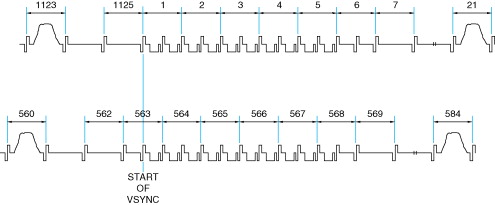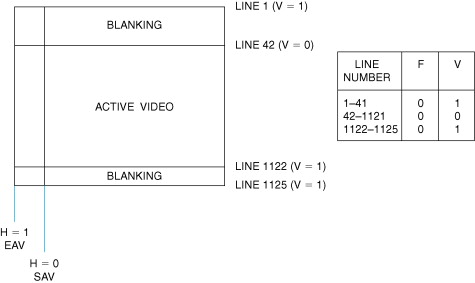1080i and 1080p Systems
Interlaced Analog Component Video
Analog component signals are comprised of three signals, analog R′G′B′ or YPbPr. Referred to as 1080i (since there are typically 1080 active scan lines per frame and they are interlaced), the frame rate is usually 25 or 29.97 Hz (30/1.001) to simplify the generation of (B, D, G, H, I) PAL or (M) NTSC video. The analog interface uses 1125 lines per frame, with active video present on lines 21–560 and 584–1123, as shown in Figure 3.30.
FIGURE 3.30. 1080i Vertical Interval Timing.

MPEG-2 and MPEG-4 systems use 1088 lines, rather than 1080, in order to have a multiple of 32 scan lines per frame. In this case, an additional 4 lines per field after the active video are used.
For the 25 Hz frame rate, each scan line time is about 35.56 μs. For the 29.97 Hz frame rate, each scan line time is about 29.66 μs. Detailed horizontal timing is dependent on the specific video interface used, as discussed in Chapter 4.
Insider Info
The 1152i active (1250 total) line format is not a broadcast transmission format. However, it is being used as an analog interconnection standard from high-definition (HD) set-top boxes and DVD players to 50-Hz CRT-based HDTVs. This enables 50-Hz HDTVs to use a fixed 31.25 kHz horizontal frequency, reducing their cost. Other HDTV display technologies, such as DLP, LCD, and plasma, are capable of handling the native timing of 720p50 (750p50 with VBI) and 1080i25 (1125i25 with VBI) analog signals.
Progressive Analog Component Video
Analog component signals are comprised of three signals, analog R′G′B′ or YPbPr. Referred to as 1080p (since there are typically 1080 active scan lines per frame and they are progressive), the frame rate is usually 50 or 59.94 Hz (60/1.001) to simplify the generation of (B, D, G, H, I) PAL or (M) NTSC video. The analog interface uses 1125 lines per frame, with active video present on lines 42–1121, as shown in Figure 3.31.
FIGURE 3.31. 1080p Vertical Interval Timing.

MPEG-2 and MPEG-4 systems use 1088 lines, rather than 1080, in order to have a multiple of 16 scan lines per frame. In this case, an additional 8 lines per frame after the active video are used.
For the 50-Hz frame rate, each scan line time is about 17.78 μs. For the 59.94-Hz frame rate, each scan line time is about 14.83 μs. Detailed horizontal timing is dependent on the specific video interface used, as discussed in Chapter 4.
Interlaced Digital Component Video
ITU-R BT.709 and SMPTE 274M specify the digital component format for the 1080i digital R′G′B′ or YCbCr signal. Active resolutions defined within BT.709 and SMPTE 274M, their 1× Y and R′G′B′ sample rates (Fs), and frame rates, are:
| 1920×1080i | 74.250 MHz | 25.00 Hz |
| 1920×1080i | 74.176 MHz | 29.97 Hz |
| 1920×1080i | 74.250 MHz | 30.00 Hz |
Note that square pixels and a 16:9 aspect ratio are used. Other common active resolutions, their 1× Y and R′G′B′ sample rates (Fs), and frame rates, are:
| 1280×1080i | 49.500 MHz | 25.00 Hz |
| 1280×1080i | 49.451 MHz | 29.97 Hz |
| 1280×1080i | 49.500 MHz | 30.00 Hz |
| 1440×1080i | 55.688 MHz | 25.00 Hz |
| 1440×1080i | 55.632 MHz | 29.97 Hz |
| 1440×1080i | 55.688 MHz | 30.00 Hz |
Example relationships between the analog and digital signals are shown in Figures 3.32 and 3.33, and Table 3.2. The H (horizontal blanking) and V (vertical blanking) signals are as defined in Figure 3.34.
FIGURE 3.32. 1080i Analog-Digital Relationship (16:9 Aspect Ratio, 29.97 Hz Frame Rate, 74.176 MHz Sample Clock and 30 Hz Frame Rate, 74.25 MHz Sample Clock).

FIGURE 3.33. General 1080i Analog-Digital Relationship.

Table 3.2. Various 1080i analog-digital parameters for Figure 3.33
| Active Horizontal Samples (A) | Frame Rate (Hz) | 13 Y Sample Rate (MHz) | Total Horizontal Samples (B) | Horizontal Blanking Samples (C) | D Samples |
|---|---|---|---|---|---|
| 1920 | 251 | 72 | 2304 | 384 | 32 |
| 251 | 74.25 | 2376 | 456 | 38 | |
| 25 | 74.25 | 2640 | 720 | 528 | |
| 30/1.001 | 74.25/1.001 | 2200 | 280 | 88 | |
| 30 | 74.25 | 2200 | 280 | 88 | |
| 1440 | 251 | 54 | 1728 | 288 | 24 |
| 25 | 55.6875 | 1980 | 540 | 396 | |
| 30/1.001 | 55.6875/ | 1650 | 210 | 66 | |
| 1.001 | |||||
| 30 | 55.6875 | 1650 | 210 | 66 | |
| 1280 | 251 | 48 | 1536 | 256 | 21 |
| 25 | 49.5 | 1760 | 480 | 352 | |
| 30/1.001 | 49.5/1.001 | 1466.7 | 186.7 | 58.7 | |
| 30 | 49.5 | 1466.7 | 186.7 | 58.7 |
Notes: 1. Useful for CRT-based 50 Hz HDTVs based on a 31.250 kHz horizontal frequency. Sync pulses are 2300 mV bi-level, rather than 6300 mV tri-level. 1080i content letterboxed in 1152i active scan lines; 1250i total scan lines instead of 1125i.
FIGURE 3.34. 1080i Digital Vertical Timing (1080 Active Lines). F and V change state at the EAV sequence at the beginning of the digital line. Note that the digital line number changes state prior to the start of horizontal sync, as shown in Figures 3.32 and 3.33.

Progressive Digital Component Video
ITU-R BT.709 and SMPTE 274M specify the digital component format for the 1080p digital R′G′B′ or YCbCr signal. Active resolutions defined within BT.709 and SMPTE 274M, their 1× Y and R′G′B′ sample rates (Fs), and frame rates, are:
| 1920×1080p | 74.176 MHz | 23.976 Hz |
| 1920×1080p | 74.250 MHz | 24.000 Hz |
| 1920×1080p | 74.250 MHz | 25.000 Hz |
| 1920×1080p | 74.176 MHz | 29.970 Hz |
| 1920×1080p | 74.250 MHz | 30.000 Hz |
| 1920×1080p | 148.50 MHz | 50.000 Hz |
| 1920×1080p | 148.35 MHz | 59.940 Hz |
| 1920×1080p | 148.50 MHz | 60.000 Hz |
Note that square pixels and a 16:9 aspect ratio are used. Other common active resolutions, their 1× Y and R′G′B′ sample rates (Fs), and frame rates, are:
| 1280×1080p | 49.451 MHz | 23.976 Hz |
| 1280×1080p | 49.500 MHz | 24.000 Hz |
| 1280×1080p | 49.500 MHz | 25.000 Hz |
| 1280×1080p | 49.451 MHz | 29.970 Hz |
| 1280×1080p | 49.500 MHz | 30.000 Hz |
| 1280×1080p | 99.000 MHz | 50.000 Hz |
| 1280×1080p | 98.901 MHz | 59.940 Hz |
| 1280×1080p | 99.000 MHz | 60.000 Hz |
| 1440×1080p | 55.632 MHz | 23.976 Hz |
| 1440×1080p | 55.688 MHz | 24.000 Hz |
| 1440×1080p | 55.688 MHz | 25.000 Hz |
| 1440×1080p | 55.632 MHz | 29.970 Hz |
| 1440×1080p | 55.688 MHz | 30.000 Hz |
| 1440×1080p | 111.38 MHz | 50.000 Hz |
| 1440×1080p | 111.26 MHz | 59.940 Hz |
| 1440×1080p | 111.38 MHz | 60.000 Hz |
Example relationships between the analog and digital signals are shown in Figures 3.35 and 3.36, and Table 3.3. The H (horizontal blanking), V (vertical blanking), and F (field) signals are as defined in Figure 3.37.
Insider Info
Some consumer displays, such as those based on LCD and plasma technologies, have adapted other resolutions as their native resolution. Common active resolutions and their names are:
640×400 VGA 640×480 VGA 854×480 WVGA 800×600 SVGA 1024×768 XGA 1280×768 WXGA 1366×768 WXGA 1024×1024 XGA 1280×1024 SXGA 1600×1024 WSXGA 1600×1200 UXGA 1920×1200 WUXGA These resolutions, and their timings, are defined for computer monitors by the Video Electronics Standards Association (VESA). Displays based on one of these native resolutions are usually capable of accepting many input resolutions, scaling the source to match the display resolution.
FIGURE 3.35. 1080p Analog-Digital Relationship (16:9 Aspect Ratio, 59.94 Hz Frame Rate, 148.35 MHz Sample Clock and 60 Hz Frame Rate, 148.5 MHz Sample Clock).

FIGURE 3.36. General 1080p Analog-Digital Relationship.

Table 3.3. Various 1080p Analog-Digital Parameters for Figure 3.36
| Active Horizontal Samples (A) | Frame Rate (Hz) | 13 Y Sample Rate (MHz) | Total Horizontal Samples (B) | Horizontal Blanking Samples (C) | D Samples |
|---|---|---|---|---|---|
| 1920 | 24/1.001 | 74.25/1.001 | 2750 | 830 | 638 |
| 24 | 74.25 | 2750 | 830 | 638 | |
| 25 | 74.25 | 2640 | 720 | 528 | |
| 30/1.001 | 74.25/1.001 | 2200 | 280 | 88 | |
| 30 | 74.25 | 2200 | 280 | 88 | |
| 50 | 148.5 | 2640 | 720 | 528 | |
| 60/1.001 | 148.5/1.001 | 2200 | 280 | 88 | |
| 60 | 148.5 | 2200 | 280 | 88 | |
| 1440 | 24/1.001 | 55.6875/1.001 | 2062.5 | 622.5 | 478.5 |
| 24 | 55.6875 | 2062.5 | 622.5 | 478.5 | |
| 25 | 55.6875 | 1980 | 540 | 396 | |
| 30/1.001 | 55.6875/1.001 | 1650 | 210 | 66 | |
| 30 | 55.6875 | 1650 | 210 | 66 | |
| 50 | 111.375 | 1980 | 540 | 396 | |
| 60/1.001 | 111.375/1.001 | 1650 | 210 | 66 | |
| 60 | 111.375 | 1650 | 210 | 66 | |
| 1280 | 24/1.001 | 49.5/1.001 | 1833.3 | 553.3 | 425.3 |
| 24 | 49.5 | 1833.3 | 553.3 | 425.3 | |
| 25 | 49.5 | 1760 | 480 | 352 | |
| 30/1.001 | 49.5/1.001 | 1466.7 | 186.7 | 58.7 | |
| 30 | 49.5 | 1466.7 | 186.7 | 58.7 | |
| 50 | 99 | 1760 | 480 | 352 | |
| 60/1.001 | 99/1.001 | 1466.7 | 186.7 | 58.7 | |
| 60 | 99 | 1466.7 | 186.7 | 58.7 |
FIGURE 3.37. 1080p Digital Vertical Timing (1080 Active Lines). V changes state at the EAV sequence at the beginning of the digital line. Note that the digital line number changes state prior to the start of horizontal sync, as shown in Figures 3.35 and 3.36.

Instant summary
Video signals come in many “flavors,” with a wide variety of options. These include:
- Digital component video, developed by the EBU to support simpler international program exchange
- 480i and 480p systems, which include interlaced analog composite video, interlaced analog component video, progressive analog component video, interlaced digital component video, and progressive digital component video at 480 active scan lines per frame
- 576i and 576p systems, which include analog composite video, interlaced analog component video, progressive analog component video, interlaced digital component video, and progressive digital component video at 576 active scan lines per frame
- 720p systems, which include progressive analog component video and progressive digital component video at 720 active scan lines per frame
- 1080i and 1080p systems, which include interlaced analog component video, progressive analog component video, interlaced digital component video, and progressive digital component video at 1080 active scan lines per frame
